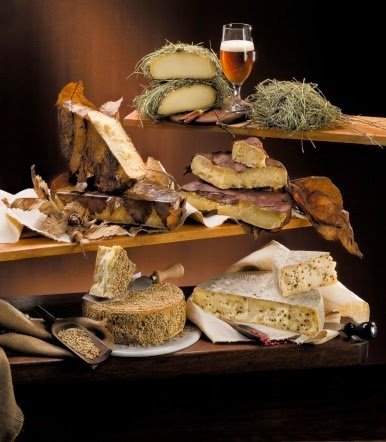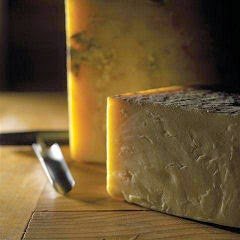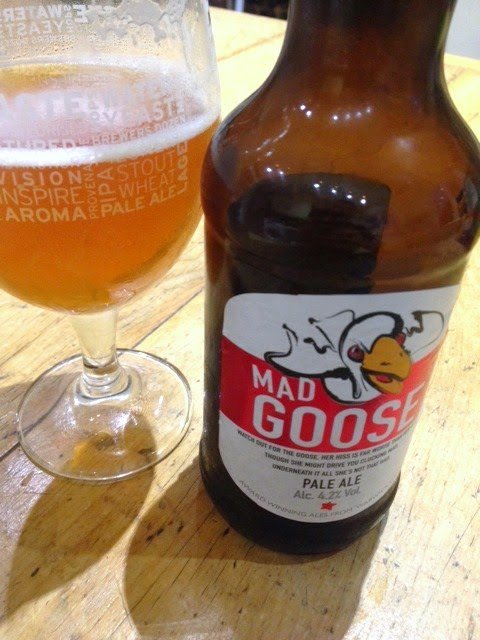It has a natural grey rind (no bandages or butter) and is matured for three months. Similar to Cheshire or Wensleydale, but with its own unique character, Anster has a crumbly, open texture and a fresh, milky flavour with lemony notes. I also detected a satisfying savoury finish to the cheese that was mushroomy and almost meaty (I suspect that came from the rind.)
6 Mar 2015
Cheese of the Week: Anster
It has a natural grey rind (no bandages or butter) and is matured for three months. Similar to Cheshire or Wensleydale, but with its own unique character, Anster has a crumbly, open texture and a fresh, milky flavour with lemony notes. I also detected a satisfying savoury finish to the cheese that was mushroomy and almost meaty (I suspect that came from the rind.)
8 Sep 2014
CHEESE OF THE WEEK: Västerbottensost
Without
coming over all new age, there is something beautifully holistic and
harmonious when a cheese naturally matches a wine or beer made in the
same area. It's hard not to get a warm fuzzy local food feeling about
classic combos such as Comté with 'vin jaune' (yellow wine), which are
both made in the Jura mountains, or a slice of Westcombe cheddar with a
Somerset cider.
Then
there are those completely random match ups, which have nothing to do
to with each other, but just work really well together.
31 Jul 2014
CHEESE OF THE WEEK: Occelli in chestnut leaves
 |
| Beppino Occelli's range of grand cheeses are wrapped in everything from straw to tobacco leaves |
Mention the words
'flavoured cheese' to a serious fromage lover and their face will
usually fall into a stern look of disapproval. At the big
international cheese awards, this class is generally full of products
laced with cranberries, mango and curry powder and are widely
dismissed (rightly in my view) as being awful gimmicks.
But as with so many
things in life, you can't generalise. There are some terrific
flavoured cheeses. Lynher Dairies in Cornwall is a case in point.
It's nettle-wrapped Cornish Yarg is a modern British classic, while
its lesser known Wild Garlic Yarg won the Flavour Added Cheese
category at this year's British Cheeses Awards.
10 Jul 2014
CHEESE OF THE WEEK: Quickes Vintage
 I paired this cheese
with a cider at a recent event I organised with the Brighton Food Society and it went down a storm. Devon producer Quickes Traditional
ages most of its cheddars for around a year, but some have the
potential to be matured for much longer. Quickes Vintage, which is
made with pasteurised milk, is 24 months old when it is released,
making it one of the most mature farmhouse cheddars in the country.
I paired this cheese
with a cider at a recent event I organised with the Brighton Food Society and it went down a storm. Devon producer Quickes Traditional
ages most of its cheddars for around a year, but some have the
potential to be matured for much longer. Quickes Vintage, which is
made with pasteurised milk, is 24 months old when it is released,
making it one of the most mature farmhouse cheddars in the country.
Owner Mary Quicke
describes her cheeses as being “10-mile cheddars” in that if she
tastes a piece before driving away from the farm, the flavour will
still be developing on the palate 10 miles later. Unlike über sweet
block cheddars, Quickes Vintage has what Mary describes as a 'grand
staircase of flavours' taking in creaminess, intense savoury 'umami'
notes and a lovely mellow caramel sweetness.
19 Apr 2013
CHEESE OF THE WEEK: Winslade
The cheese in the picture above might look like a Vacherin, but it is in fact a new British cheese called Winslade from the company that makes the fabulous Camembert-style Tunworth.
Like Vacherin, Winslade has a runny texture when it's fully ripe so you can eat it with a
spoon. The flavour is delicate - creamy and mushroomy with interesting resinous notes fom the spruce
Hedges deveolped the
cheese after a discusssion with Neal's Yard Dairy, which was
looking to stock a new kind of British cheese. The retailer is the
only one currently selling Winslade, although it is also cropping up on restaurant menus quite a bit. I saw it at Rotunda near Kings Cross recently, where it's served hot from the oven with walnut and raisin bread for dunking.
Where to buy: Neal's Yard
How to eat: Sprinkle with white wine and warm in the oven. Serve with crusty bread for dipping.
What to drink: A crisp Sancerre or a fruity Beaujolais.
How to eat: Sprinkle with white wine and warm in the oven. Serve with crusty bread for dipping.
What to drink: A crisp Sancerre or a fruity Beaujolais.
15 Jun 2012
CHEESE OF THE WEEK: Ossau-Iraty
Just because a cheese
is made in small batches by hand on a farm doesn't necessarily make
it a good cheese. Sometimes big dairies do a much better job of
making 'artisan' cheeses because they have the technical knowledge
and experience.
That's what outspoken
Cumbrian cheesemonger and maker Martin Gott told me in a recent
interview anyway. Not long after speaking to Martin, I was sent some Ossau-Iraty, which seemed to proved his point.
Intensely sweet and
salty with the most amazing flavours of dried porcini mushrooms and
curry leaves (no really, it's true!) it was an absolute corker of a
cheese.
An Ossau-Iraty was
named supreme champion at last year's World Cheese Awards, and like
that cheese Onetik's is matured slightly longer than most (about nine
months), which explains the intensity of flavour. It's made with raw
ewe's milk and has a firm, supple texture and dense consistency. Distinctive earthy rind as well.
Definitely worth
checking out.
Where to buy: It's
imported by the Cheese Cellar, who supply independent cheesemongers and
delis.
What to eat: It's
traditionally served with a black cherry jam
What to drink: A sweet
white would work well with the salt. Sauternes perhaps.
14 May 2012
CHEESE OF THE WEEK: Cotherstone
One of my more
interesting cheese finds of recent weeks came at the Neal's Yard
tasting I attended last month. The first cheese of the evening was a
pale yellow, crumbly little number called Cotherstone, which I had
never heard of before even though it's far from being a new cheese.
Joan Cross has been
making Cotherstone to a recipe handed down from her mother for over
30 years. Initially she made it in her kitchen in Barnard Castle,
County Durham, leaving the milk to sour naturally in a big milk
churn. Things have moved on a bit since then, but she still makes it
in very small batches at Quarry Farm. Such small scale production, combined with the fact that she is the last remaining producer of this type of cheese, helps explain why I hadn't come across Cotherstone before. This is a very rare cheese.
It's made with
pasteurised cow's milk and is a bit like a Wensleydale in that its
moist and crumbly with a lemony tang. But the piece that I had also
had a creamy layer just under the rind that had broken down and was
much softer with a rich mushroomy flavour.
According to Neal's
Yard, Cotherstone is technically not very complicated to make:
“Basically the milk is soured, set, milled and moulded.” These
kinds of fresh crumbly cheeses, sometimes known as Dales-style
cheeses, are associated with the rugged landscapes of Yorkshire and
the North East where it was traditionally hard to farm large herds of
cattle.
Farmers would only make small amounts of cheese at home to
feed their family and perhaps have a bit left over to sell at market,
so they tended to be simple to make and eaten when they were young.
There's more on the history of Cotherstone here.
How to eat: Nice with a slice of Parkin cake.
What to drink: We had
it with a Belgian ale called Saison Dupont, which had a bit of
zesty fruitiness going on. Good beer.
11 Nov 2011
CHEESE OF THE WEEK: Abbaye de Belloc
Cheese lovers might not realise it, but they owe a debt of gratitude to monks. From Munster to Wensleydale, via Grana Padano and Epoisses, some of the world's greatest cheeses were developed in Medieval monasteries by Benedictine monks as part of a belief in prayer combined with work and self sufficiency.
It seems strange in this age of modern food manufacturing but monks are still making cheese today. I recently took home a lovely chunk of Abbaye de Belloc from a visit to Raoul's Deli in Maida Vale, London, where owner Geraldine Leventis told me it ranks as one of her best selling cheeses.
An unpasteurised hard ewes' milk cheese, Abbaye de Belloc was first developed in the 1960s by the monks of the abbey of Notre-Dame de Belloc, close to the Pyrenees in the South West of France, and they are still making it today.
Based on an Ossau Iraty recipe, the cheese is made with milk from the local red-nosed Manech breed of sheep between July and December and is dusted with paprika to help develop its pretty speckled brown rind. It's aged for 4-10 months.
I'm not sure how long the cheese I tried had been matured, but I'm guessing it was still relatively young. It had a lovely supple texture with a sweet creamy flavour that developed to nutty caramel with just a touch of wet wool (try it and you'll see what I mean!)
I'd advise against chutneys and pickles. It's a delicate cheese that deserves your full contemplation.
Where to buy: Raoul's Deli, Henri of Edinburgh, La Cave a Fromage
How to eat: Slice and eat. Don't mess about with chutney.
What to drink: A creamy white Burgundy works well, or try a nutty Manzanilla Pasada sherry.
It seems strange in this age of modern food manufacturing but monks are still making cheese today. I recently took home a lovely chunk of Abbaye de Belloc from a visit to Raoul's Deli in Maida Vale, London, where owner Geraldine Leventis told me it ranks as one of her best selling cheeses.
An unpasteurised hard ewes' milk cheese, Abbaye de Belloc was first developed in the 1960s by the monks of the abbey of Notre-Dame de Belloc, close to the Pyrenees in the South West of France, and they are still making it today.
Based on an Ossau Iraty recipe, the cheese is made with milk from the local red-nosed Manech breed of sheep between July and December and is dusted with paprika to help develop its pretty speckled brown rind. It's aged for 4-10 months.
I'm not sure how long the cheese I tried had been matured, but I'm guessing it was still relatively young. It had a lovely supple texture with a sweet creamy flavour that developed to nutty caramel with just a touch of wet wool (try it and you'll see what I mean!)
I'd advise against chutneys and pickles. It's a delicate cheese that deserves your full contemplation.
Where to buy: Raoul's Deli, Henri of Edinburgh, La Cave a Fromage
How to eat: Slice and eat. Don't mess about with chutney.
What to drink: A creamy white Burgundy works well, or try a nutty Manzanilla Pasada sherry.
30 Oct 2011
CHEESE OF THE WEEK: Ragstone
I got a bit over-excited in a previous post about how some British cheesemakers are going back to using traditional calves' rennet in their cheeses (rather than vegetarian) because they believe it gives a more rounded, 3D flavour.
Following on from that, and just by coincidence, I picked up a small log of Ragstone goat's cheese from Neal's Yard Dairy at Borough Market, which is made with kids' rennet.
Logically, you would think that all traditional goats' cheeses would be made with kids' rennet, but it's actually very unusual in the UK. A lot of goat's cheese producers here use vegetarian or calves' rennet, but cheesemaker Charlie Westhead swears by keeping it 100% goat. He thinks it adds "an extra dimension" to the flavour of the cheese, which echoes what cheesemakers in my previous piece were saying.
Anyway rennet ramble over, Ragstone is a pretty cheese with a velvety white rind and smooth interior. It's made with unpasteurised goat's milk in Herefordshire overlooking the River Wye by Neal's Yard Creamery. The company was originally based in the South East of England and was part of Neal's Yard Dairy, but it is now completely separate and relocated to Herefordshire in 1996.
The piece I bought in mid October had a rich creamy flavour with lemony, herby notes and an earthy finish. There was an interesting mix of textures as well with the silky rind giving way to an oozy outer layer and a smooth paste inside. Best of all, the flavours and the textures all seemed to balance each other really well.
Sometimes there's a macho swagger to goat's cheese - the billy goat flavour is just too overpowering - but not with Ragstone. It's a harmonious little cheese.
Where to buy: Neal's Yard Dairy, Paxton & Whitfield, IJ Mellis, Whole Foods Market
How to eat: This is a versatile cheese, which works on a cheeseboard, but is also great in salads, tarts and sandwiches. Try it in a salad with pear and walnuts, or grilled with marmalade in a sandwich. Beetroot and rosemary are also friendly flavours.
What to drink: A grassy sauvignon blanc from the Loire Valley is a classic accompaniment to goat's cheese. The CheeseWorks in Cheltenham recommends a crisp English white from the Three Choirs Vineyard called Coleridge Hill
Following on from that, and just by coincidence, I picked up a small log of Ragstone goat's cheese from Neal's Yard Dairy at Borough Market, which is made with kids' rennet.
Logically, you would think that all traditional goats' cheeses would be made with kids' rennet, but it's actually very unusual in the UK. A lot of goat's cheese producers here use vegetarian or calves' rennet, but cheesemaker Charlie Westhead swears by keeping it 100% goat. He thinks it adds "an extra dimension" to the flavour of the cheese, which echoes what cheesemakers in my previous piece were saying.
Anyway rennet ramble over, Ragstone is a pretty cheese with a velvety white rind and smooth interior. It's made with unpasteurised goat's milk in Herefordshire overlooking the River Wye by Neal's Yard Creamery. The company was originally based in the South East of England and was part of Neal's Yard Dairy, but it is now completely separate and relocated to Herefordshire in 1996.
The piece I bought in mid October had a rich creamy flavour with lemony, herby notes and an earthy finish. There was an interesting mix of textures as well with the silky rind giving way to an oozy outer layer and a smooth paste inside. Best of all, the flavours and the textures all seemed to balance each other really well.
Sometimes there's a macho swagger to goat's cheese - the billy goat flavour is just too overpowering - but not with Ragstone. It's a harmonious little cheese.
Where to buy: Neal's Yard Dairy, Paxton & Whitfield, IJ Mellis, Whole Foods Market
How to eat: This is a versatile cheese, which works on a cheeseboard, but is also great in salads, tarts and sandwiches. Try it in a salad with pear and walnuts, or grilled with marmalade in a sandwich. Beetroot and rosemary are also friendly flavours.
What to drink: A grassy sauvignon blanc from the Loire Valley is a classic accompaniment to goat's cheese. The CheeseWorks in Cheltenham recommends a crisp English white from the Three Choirs Vineyard called Coleridge Hill
21 Oct 2011
CHEESE OF THE WEEK: Berwick Edge
Unless you live in the North East of England, you might not be familiar with Berwick Edge, which is made by Doddington Dairy in Northumberland and is mainly available in regional delis and farm shops.
That's a shame because this unpasteurised Gouda-style cheese, which is aged for between 12-24 months, is an absolute cracker. The cheese I tried managed to retain the milky freshness of its youth while also possessing those fruity caramel flavours that come with age. There was a nice salty hit to it as well.
Don't just take my word for it either. Members of the Specialist Cheesemakers' Association awarded it with the 2011 James Aldridge Memorial Trophy earlier this year, which goes to the UK's best raw milk cheese.
Don't just take my word for it either. Members of the Specialist Cheesemakers' Association awarded it with the 2011 James Aldridge Memorial Trophy earlier this year, which goes to the UK's best raw milk cheese.
The trophy is named after legendary cheesemaker and affineur James Aldridge, who helped reinvigorate the artisan cheese sector in Britian in the 1980s and 90s and passed away in 2001. In a weird twist of fate, Doddington's MD Margaret-Ann Maxwell took advice from Aldridge when she first started cheese making.
Where to buy: The Pantry, Bamburgh
How to eat: Good in sandwiches when it's young, but when it's older and fruitier it works well as cheese on toast or over pasta, or simply as part of a cheeseboard.
What to drink: Try an off-dry riesling from Germany or the Alsace. The combination of sweetness and mineral notes works well with the fruity, salty flavour of the cheese.
Subscribe to:
Posts (Atom)


